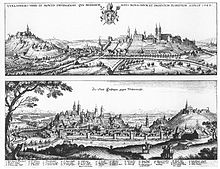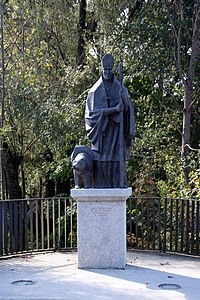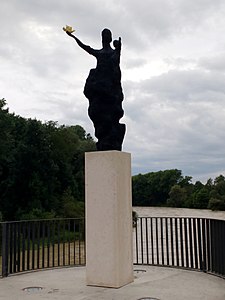Korbinian Bridge
Coordinates: 48 ° 23 ′ 50 ″ N , 11 ° 45 ′ 6 ″ E
| Korbinian Bridge | ||
|---|---|---|
| The three western arches | ||
| use | Pedestrians, cyclists, city buses | |
| Crossing of | Isar | |
| place | Freising | |
| construction | Arch bridge | |
| overall length | approx. 150 m | |
| Number of openings | 6th | |
| opening | 1893 | |
| location | ||
|
|
||
The Korbinian Bridge is an arch bridge over the Isar in Freising . The bridge is named after Saint Korbinian , who is considered the first bishop of Freising . In contrast to the Luitpold Bridge located downstream, the bridge is also called the Old Isar Bridge .
history
There are documentary mentions of a bridge from the beginning of the 14th century. However, since the city of Freising had been a ducal or bishop's seat since the 8th century and was granted market rights in 996 , one can assume the existence of a bridge for earlier times.


The bridge that Matthaeus Merian depicted around 1642 was set on fire by the Electorate of Bavaria at the end of the Thirty Years' War in 1648 to prevent the Swedes from crossing the Isar. A new bridge was built by 1650.
After the secularization, the construction of the bridge from 1807/1808 was no longer managed by Freising master builders, but by Carl Friedrich von Wiebeking . From 1805 he was the royal general director of the entire Bavarian water, bridge and road construction industry. A wooden bridge was created with only two large arches.
The current bridge was opened in 1893. An arch bridge with four openings was created. After the catastrophic flooding of the Isar in 1899, a fifth and sixth arch were built on the southern bank as additional flood openings. These two arches were made of concrete. A bridge gate was also built on the southern bank. Its sole purpose, however, was to carry the power line from Munich to Moosburg. A Johannes Nepomuk chapel was built on one of the bridge pillars .
Shortly before the end of the Second World War , the bridge was destroyed. On April 29, 1945 around 6 p.m., arches 1 and 2 were blown up by the SS in order to hinder the Allied advance. A pontoon bridge was built the next day, which, with a few exceptions, could initially only be used by the military. Within five days, a wooden pedestrian walkway was built on the blasted bridge. A bridge that can also be driven over by vehicles was built by the Freising company by June 2nd. The Korbiniansbrücke was rebuilt by 1948. The chapel and the bridge gate were demolished for reasons of traffic policy.
In 2005/2006 the two southern arches were rebuilt and the rest of the bridge renovated. In order to keep the bridge usable at least for pedestrians and cyclists during the construction work, a temporary bridge of the Bailey type was built by the THW Freising .
In the past, all traffic across the Isar ran on this bridge. In addition to the limited width of the bridge, a level crossing on the Munich – Regensburg railway line obstructed the flow of traffic a few hundred meters into town. Since 1975, the Luitpold Bridge, located 200 meters north (downstream), has handled most of the traffic. Today, apart from pedestrians and cyclists, only city buses are allowed to drive on the Korbiniansbrücke.
Bridge figures
On the wider pillars between arches 2/3 and 4/5 and at the ends of the bridge there are semicircular bulges of the walkway. There are bridge figures on seven of them.
- Karolina Gerhardinger , religious sister and founder of the Congregation of the Poor School Sisters of Our Lady .
- Johannes Nepomuk , Bohemian priest and martyr
- Korbinian , first bishop of Freising
- Lantpert von Freising , from 937 Bishop of Freising
- Otto von Freising , from 1138 Bishop of Freising and one of the most important historians of the Middle Ages
- Patrona Bavariae , Mother of God Maria as patron saint of Bavaria, artist: Carola Heine
- Boniface , missionary and church reformer; Reorganization of the dioceses of Regensburg, Freising, Passau and Salzburg in 739, artist: Bruno Wank
Originally only the statue of Nepomuk stood on the bridge. The other four statues have been added since the mid-1990s, starting with the statue of Korbinian in 1996. In that year Freising celebrated 1000 years of market rights . At the end of May 2017, further statues (Bonifatius and Patrona Bavariae) were placed in two of the free bulges. An eighth and final statue is for Benedict XVI. intended.
swell
- Fink (PDF; 7.7 MB) October 2010 p. 16 ff
- Site of a company involved in the repair (with pictures)
- Mission report and pictures of the THW Freising for the construction of the temporary bridge
- Mission report and pictures of the THW Freising for the conversion of the temporary bridge
- Mission report and pictures of the THW Freising for the dismantling of the temporary bridge
Individual evidence
- ↑ Report on the plan to set up three more bridge figures; Süddeutsche Zeitung, February 3, 2016
- ↑ Report on the unveiling of the two statues in 2017; Münchner Merkur, May 28, 2017








